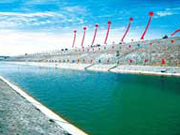China's water diversion project to tackle northern drought

 0 Comment(s)
0 Comment(s) Print
Print E-mail CNTV, September 16, 2014
E-mail CNTV, September 16, 2014
Now to a special coverage of China's South North Water Diversion Project. Testing is being carried out in different sections of the middle route of the water diversion project. The project to bring water from the south to the drought-prone areas in the north is one of the country's largest infrastructure schemes. Operation is expected to start soon, once testing is finished. Starting today, CCTV News presents a special ten-day series called "Quenching A Mighty Thirst".
Q1: And our senior reporter Han Bin joins us in the studio to tell us more about China's South-to-North Water Diversion Project. Han Bin, please start by telling us what left you with the deepest impression during the whole journey?
Han: I have to say, this water project is unprecedented not only in distance covered, but it also includes some of the most challenging engineering feats ever seen. It is a controversial project that took half a century of debate and over a decade to build. Nearly half a million people have been relocated, and the social and environmental impact has been huge. All this to quench China's thirst in the north. In the first story, we see how serious that water shortage is, and what the government is doing about it.
Conditions are the driest that farmer Kang Zhenyun has seen in his lifetime. These withered cornstalks are about all that's left.
"It's a huge loss; my entire corn crop has died. We don't even have enough drinking water. How can we irrigate the fields?" Kang said.
Kang Zhuenyun says the rivers are dry, and the villagers have had little water to drink for months. This all comes at a time when it should be flood season in Northern China. The country does have vast water resources, but they lie far to the south.
The Danjiangkou Reservoir in Central China's Hubei Province is being used as a stopgap to supply the dry lands in the north. The government is pressing ahead with one of the world's biggest engineering feats to take the water northwards.
"The dam has been raised to hold more water for the diversion. The water level can now be raised to 170 meters, ensuring an annual volume of 9.5 billion cubic meters of water to be sent," Zhang Xiaoting, chief engineer of South-North Water Transfer Project Co., said.
The chief engineer says diversion is to optimize the country's water resources. The middle route canal crisscrosses four rivers, the Yangtze, the Yellow, the Huai and Hai rivers, on its way to Beijing. All they need is enough water. Testing has been postponed because of the water shortage in the south.
The final preparations are going on at full swing behind me on this greatest of Chinese mega projects. When it goes into operation, millions of cubic meters of water will be flowing from here to the nation's capital Beijing —some 14 hundred kilometers away. The government is hoping it will alleviate the water shortage in the north without creating new problems in the south.
Despite the environmental and social impact, the government remains determined, saying the project could break the bottleneck of development and growth.
"We hope the water diversion project will bring about an economic benefit to the north by alleviating the shortage. We also hope those who sacrificed to make way for the project can find new ways to make a better living," Yuan Songling, director gen. Of Resettlement Department, NSWDP, said.
Villagers in Kangzhuang now have free drinking water delivered twice a day, courtesy of the local government.
Kang Zhenyun is hoping the canal will help ensure a bountiful harvest next year.
But with the water shortage in the south as well, what's available for the north will not be enough.
There's a long way to go before the problem can be solved.
No doubt, the water from the south will buy China time, yet it may never be enough to quench China's mighty thirst.
Q2: In your story, you mentioned that the amount of water to be transferred to the north will not be enough to ease that mighty thirst. So, why is the government so determined to carry through with the diversion?
Han: Well, it's a good question. China has a severe water shortage problem. Its fresh water resources are only a third of the global average. And in major cities like Beijing , the ground water is overused and being polluted. Taking some water from the south sounds like a realistic, ideal solution. But the amount of water is based on the water flow calculations in the past. No one foresaw climate change and or took urban expansion factors into account. So, the biggest concern is not only whether the south is also facing a water shortage with the diversion, but also wether Beijing needs to rethink its water plans for lasting development. All these questions and solutions will be addressed during the ten-day series of Quenching a Mighty Thirst. It's a complex issue, one I think viewers will find interesting.






Go to Forum >>0 Comment(s)